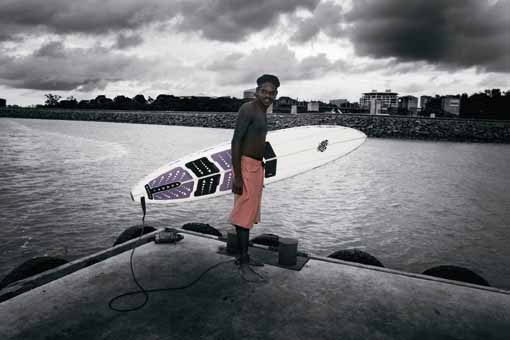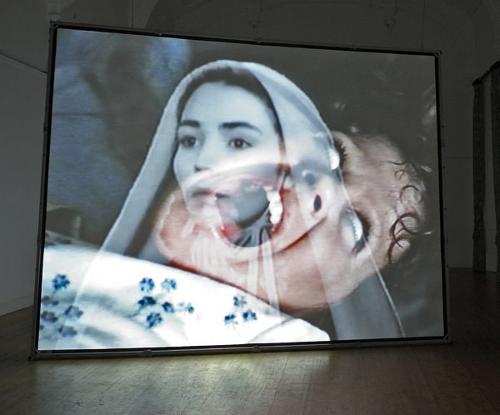
Held in the palatial surrounds of Darwin's Parliament House, the TOGart Contemporary Art Award 2007 showcased the work of twenty-eight contemporary Northern Territory artists utilising a diverse range of mediums in an impressive exhibition that builds on the success of the 2006 TOGart Contemporary show. Each show is the result of a collaboration between the NT government, the arts sector and the TOGA building group who are currently involved with the massive redevelopment of the Darwin city waterfront. It is particularly significant because of being one of the few events in the Northern Territory where the celebration of contemporary art practice moves beyond the division between 'Indigenous' and 'non-Indigenous' art. This enables broader themes such as the relationship between place and identity, the significance of memory and history within a transforming culture, an interest in the aesthetic aspects of artistic practice and the dramatic nature of the NT environment to fully emerge.
The dominant theme of 'change' within the show is unsurprising given the dramatic history and climatic conditions of the Northern Territory. Darwin has been destroyed twice, first by bombers in 1942 and then by a Cyclone in 1974. More recently, the mining boom has brought massive redevelopment that is dramatically transforming the city centre of Darwin. In the rest of the Territory, Indigenous communities have undergone immense change since the turn of last century.
Certainly, the theme of a transforming culture is central to 'Stories from the City, Stories from the Sea' by Chayni Henry. This work won the inaugural $15,000 acquisitive TOGart award selected by judges Steve Fox, Philip Bacon and William Nuttall. It presents a searingly honest depiction of scenes inspired by Chayni's life history and provides an insight into the uniqueness of a day-to-day Darwin culture that is fast disappearing due to urban redevelopment. Her varied memories of the waterfront range from the burning of Indonesian fishing boats to her participation in the 'shame-job' line dancing that used to be held down at the wharf on a Saturday night. Henry is a rising star who over the past year has been selected for the MCA's 'Primavera', featured on ABC's Sunday Arts and exhibited in various interstate galleries.
Sally Gobori painting's 'My Father's country' was a standout work in the exhibition. It depicts Bentinck Island in the Gulf of Carpentaria and signifies the importance of country to the Kaiadilt people. The painting declares the right of her people to occupy their own land since their forced removal to Mornington Island during the late 1940s. It was not until the 1980s that the Kaiadilt people had a chance to return. Now eighty-three, Sally began painting large-scale acrylic works in 2005 when she became involved with the Mornington Island Art Centre. 'My Father's Country' is painted with a confidence, boldness and clarity of vision that draws upon her profound life experience. Innovative experimentation with colour and form is also evident in many other works within the exhibition including those by Patrick Tjungarrayi, Naata Nungurrayi, Adrian Robertson and Billy Benn Perrule.
'Ichor' by Pip McManus is another pivotal work within this exhibition, leading the viewer to contemplate the cyclic process of disintegration and regeneration that characterize the natural environment. In this film of a gradually dissolving, clay spiritual icon, McManus skillfully brings together the base, ancient element of clay with contemporary DVD technology and a recorded musical soundtrack. In doing so, he creates a film of great spiritual and philosophical power. But Ichor's appeal is not limited to its exploration of universal themes. The central Buddha-like figure, implicitly acknowledges the influence of South-East Asian culture and belief upon Territory life. For those of us who daily experience the cyclic, climactic conditions of the far North, Ichor's record of disintegration and regeneration processes has a clear local resonance.
Another contemplative work that recalls the nostalgic sepia tones of an old photograph album is Kay Rintel's Apparitions at Humpty Doo. The ghost-like presence of these figures from early last century are placed in a plantation forest rather than an enchanted wood. Veiled patterns of dappled light and shade render the images indistinct, thereby suggesting the impossibility of recapturing a transient past.
'Shell' by Frank Gohier also conjures up the past, taking the bombing of Darwin as its theme. Gohier's use of cartoon imagery, toy planes and Shell signage in points to the mythologies surrounding this event. Yet despite the fact that 283 people were killed, the bombing of Darwin has not fully entered into our national consciousness. 'Shell' also alludes perhaps, to the potentially destructive influence of multinational companies in the Territory.
Like Gohier's painting, Peter Eve's photograph of an Aboriginal surfer in red shorts standing against the changing, built-up backdrop of the Darwin waterfront acts to destabilise constructions of Australian history and identity. 'Surf's up' recalls Tracey Moffat's 'The Movie Star' (1985), featuring David Gulpilil with a beatbox on Bondi Beach. Both photographs challenge the stereotypical notions of that 'Aussie icon': the blue-eyed, blonde-haired surfie. Who really possesses legitimate claim to the Australian coastline? Both these photographic works also celebrate the capacity of Indigenous people to adapt and change whilst also maintaining their cultural identity.
Fiona Morrison's photographic work 'Limen' moves from a concern with the past to a focus upon the present, confronting the viewer with the sometimes stark reality of nocturnal Darwin suburbia. The dominant focus of 'Limen' is the impenetrable brick endwall of a block of units. The units are surrounded by lurid green vegetation that is bathed in the unnatural afterglow of halogen light. This is a vision far removed from stereotypical imaginings of domestic tropical life with its louvred verandahs, lush gardens, fans and sunsets.
This is a significant exhibition that reveals the prodigious talent of artists in the Northern Territory. It shows the potential of entrepreneurial collaboration between the arts sector, government and private enterprise although it is still to be regretted that the triennial survey of art by leading contemporary artists with significant connections to the Northern Territory Contemporary Territory no longer seems to be part of the Museum and Art Gallery of the Northern Territory's agenda. It is also odd that a significant exhibition such as TOGart is on for less than three weeks and closes before the opening of the highly publicised NATSIAA Telstra Art Award that is attended by collectors, critics and curators from all over Australia.












